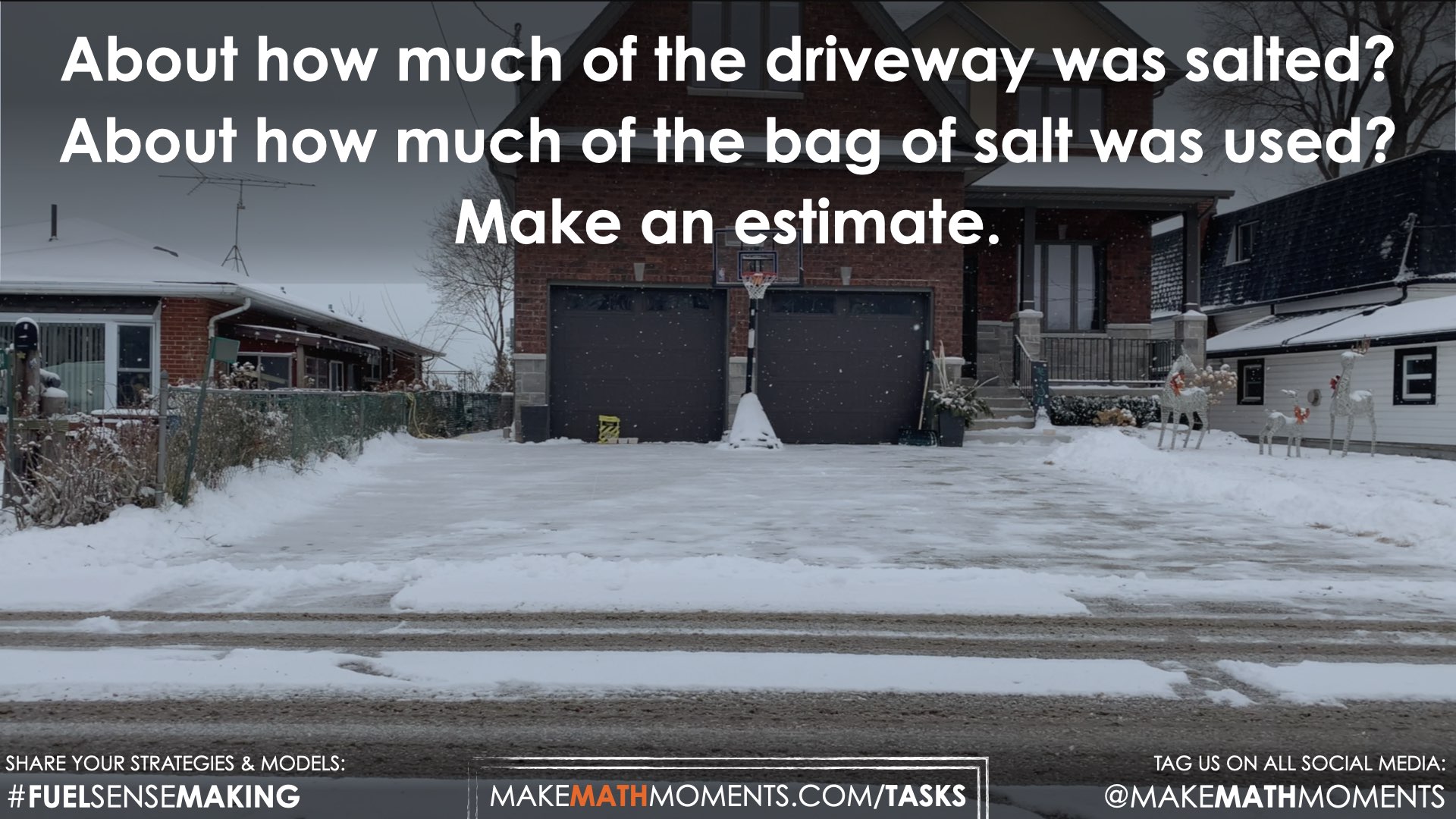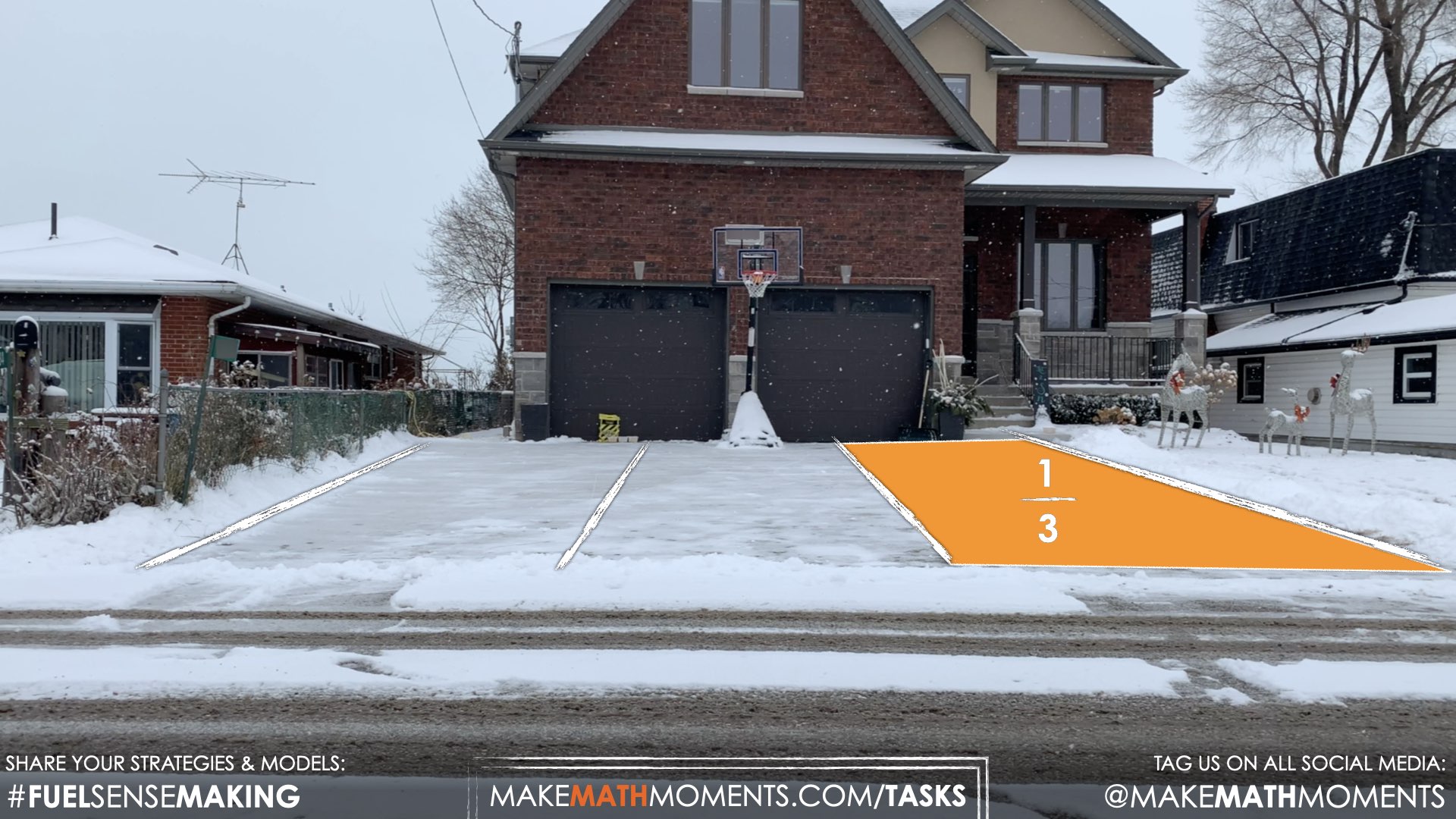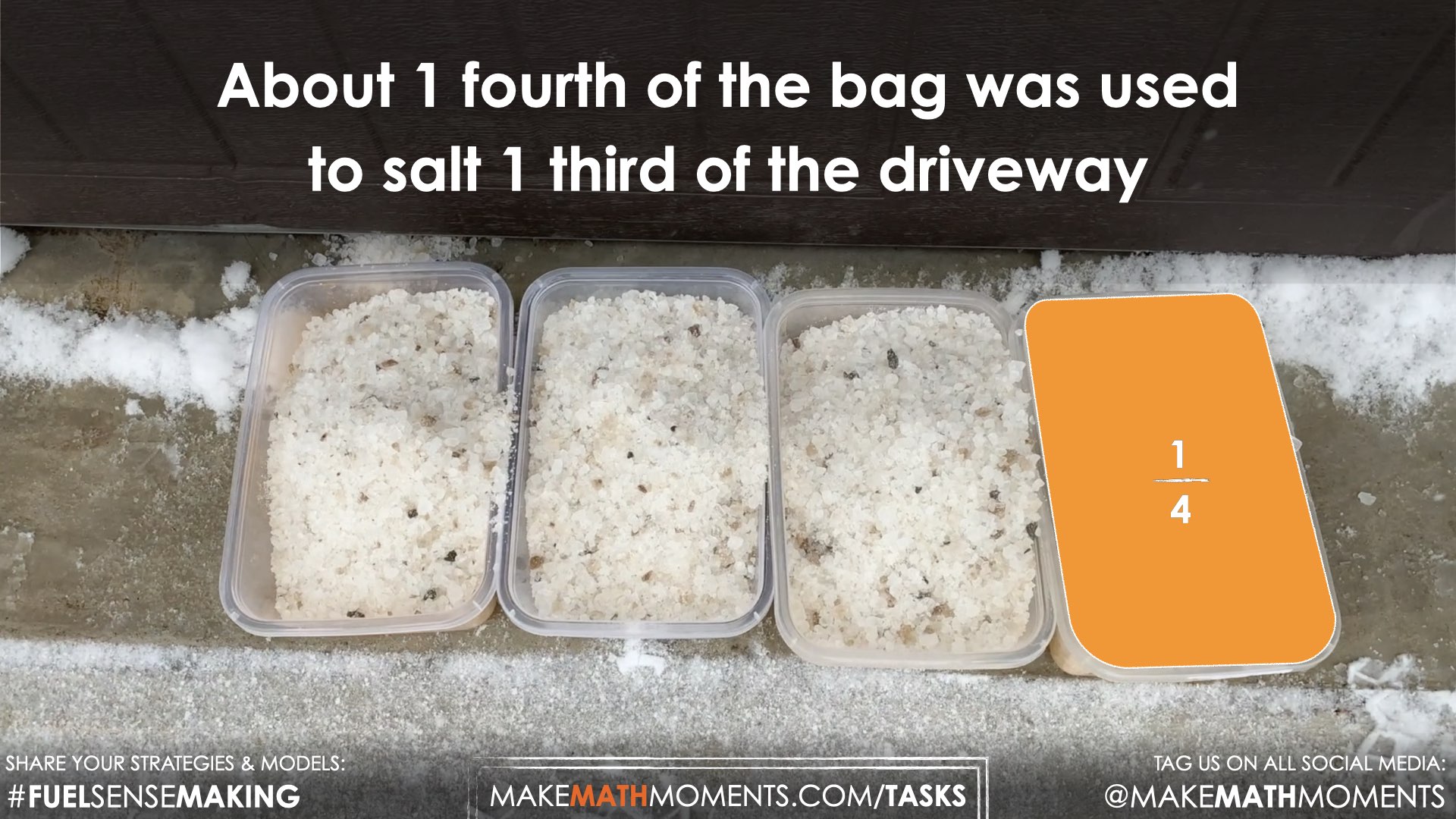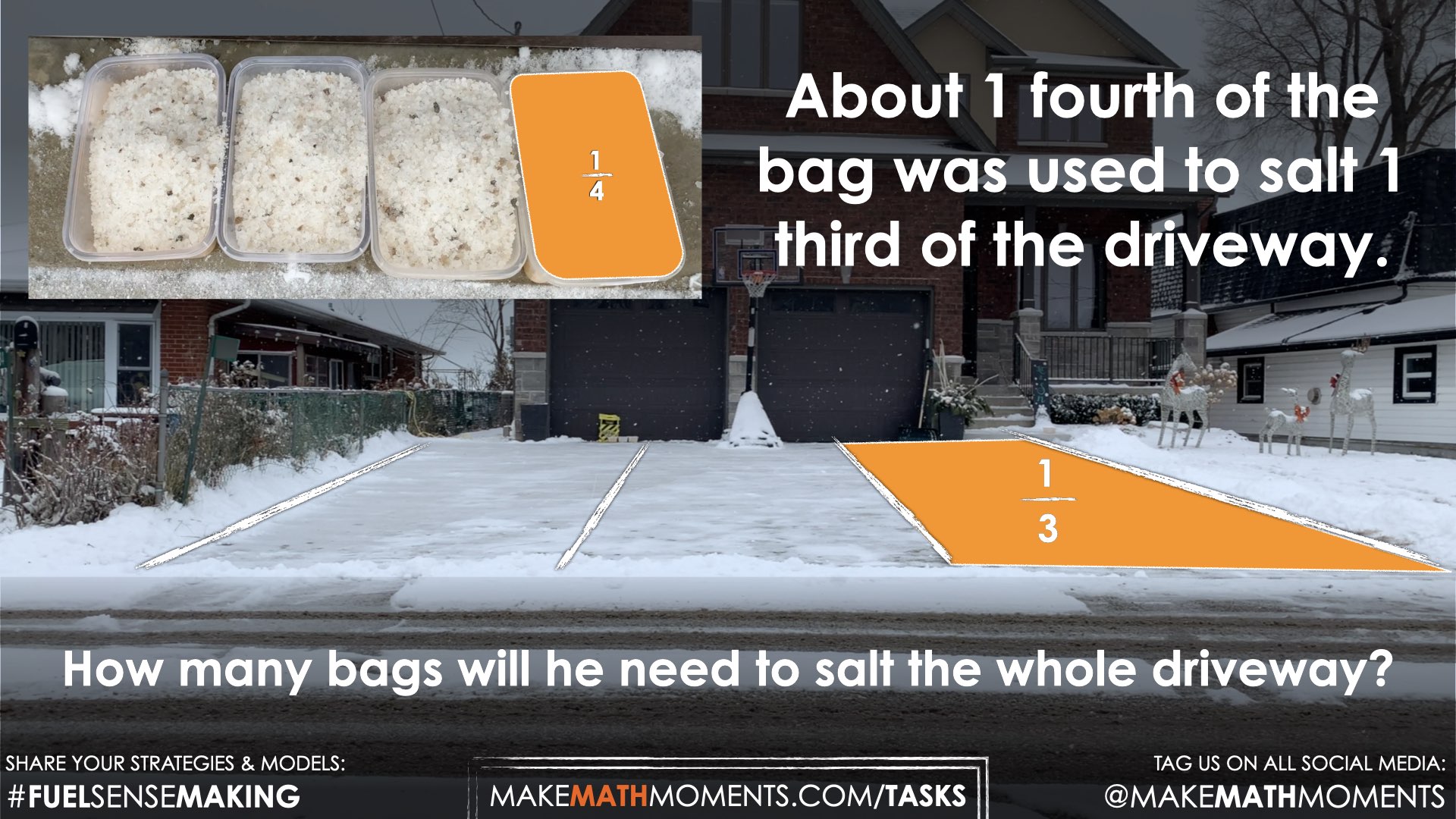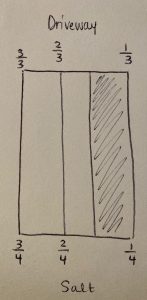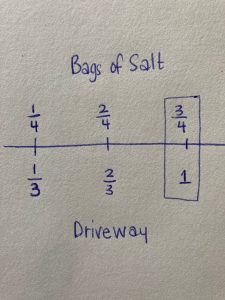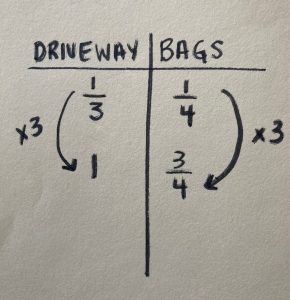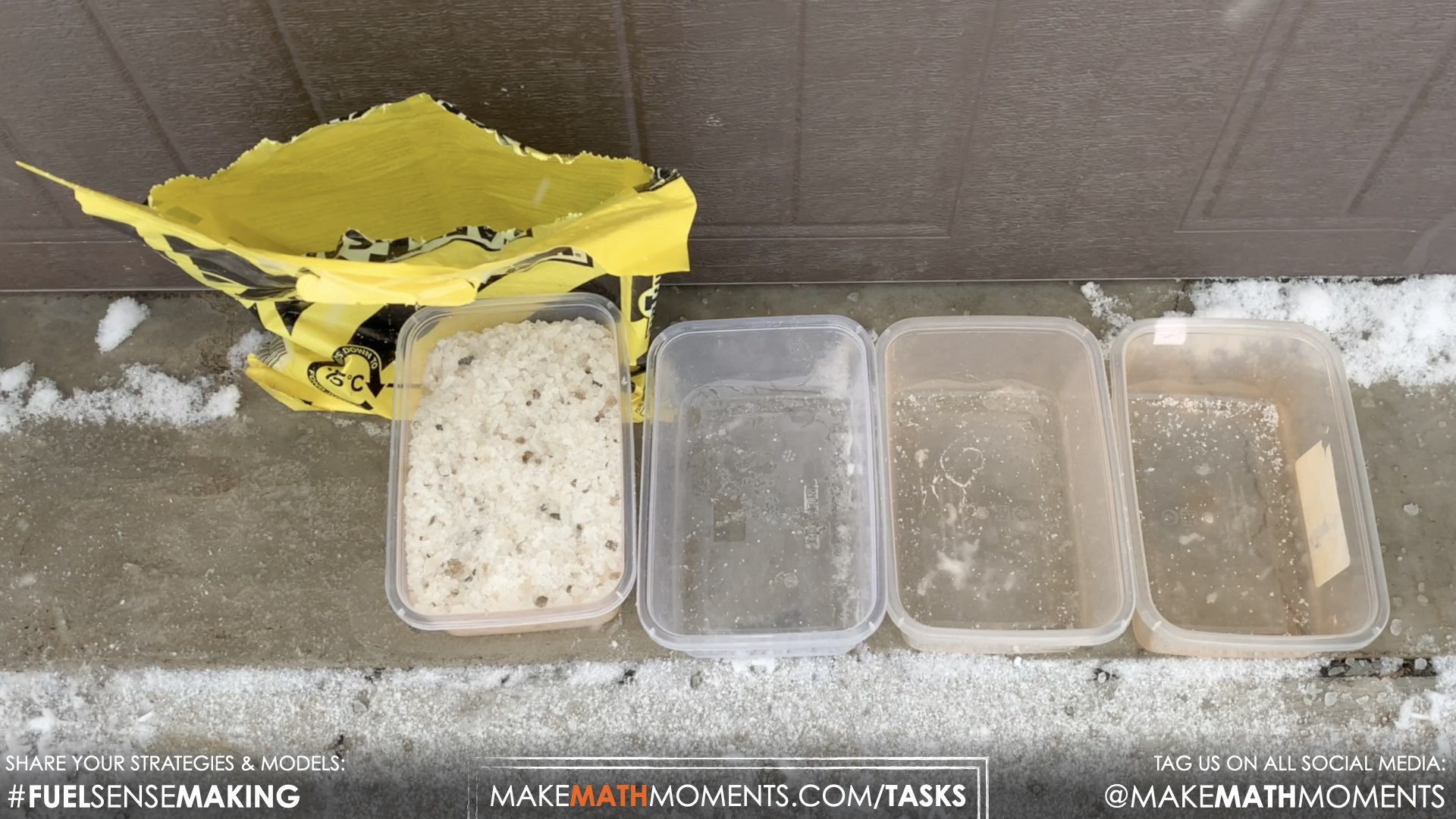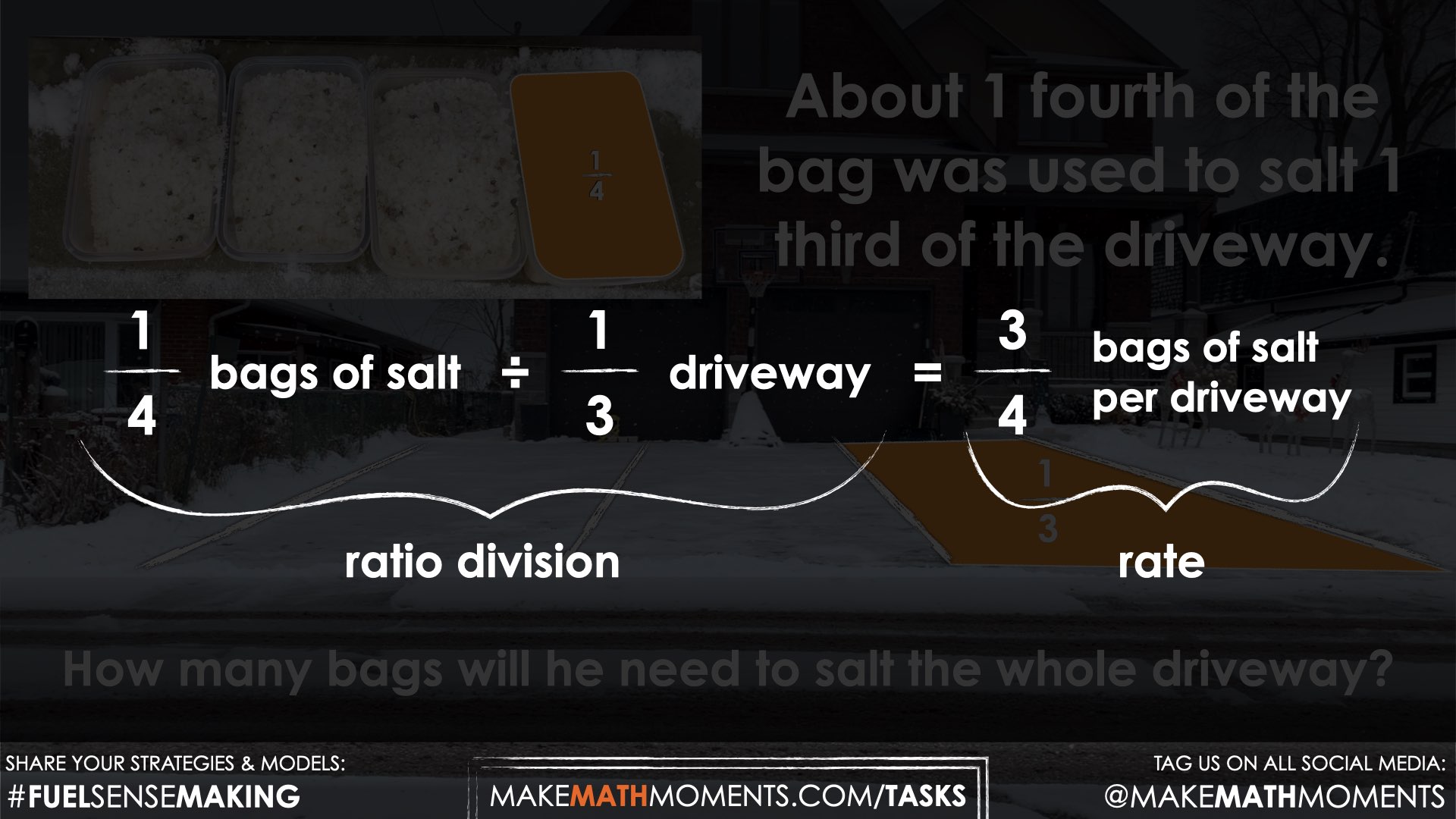SALTING THE DRIVEWAY
DIVIDING FRACTIONS THROUGH PARTITIVE DIVISION
Explore partitive division of fractions conceptually using the bar model, double number line and ratio table.
Intentionality
Spark Curiosity
Fuel Sensemaking
During Moves
Student Approaches
Next Moves
Consolidation
Reflect and Consolidation Prompts
Resources & Downloads
Educator Discussion Area
Intentionality & Unit Overview
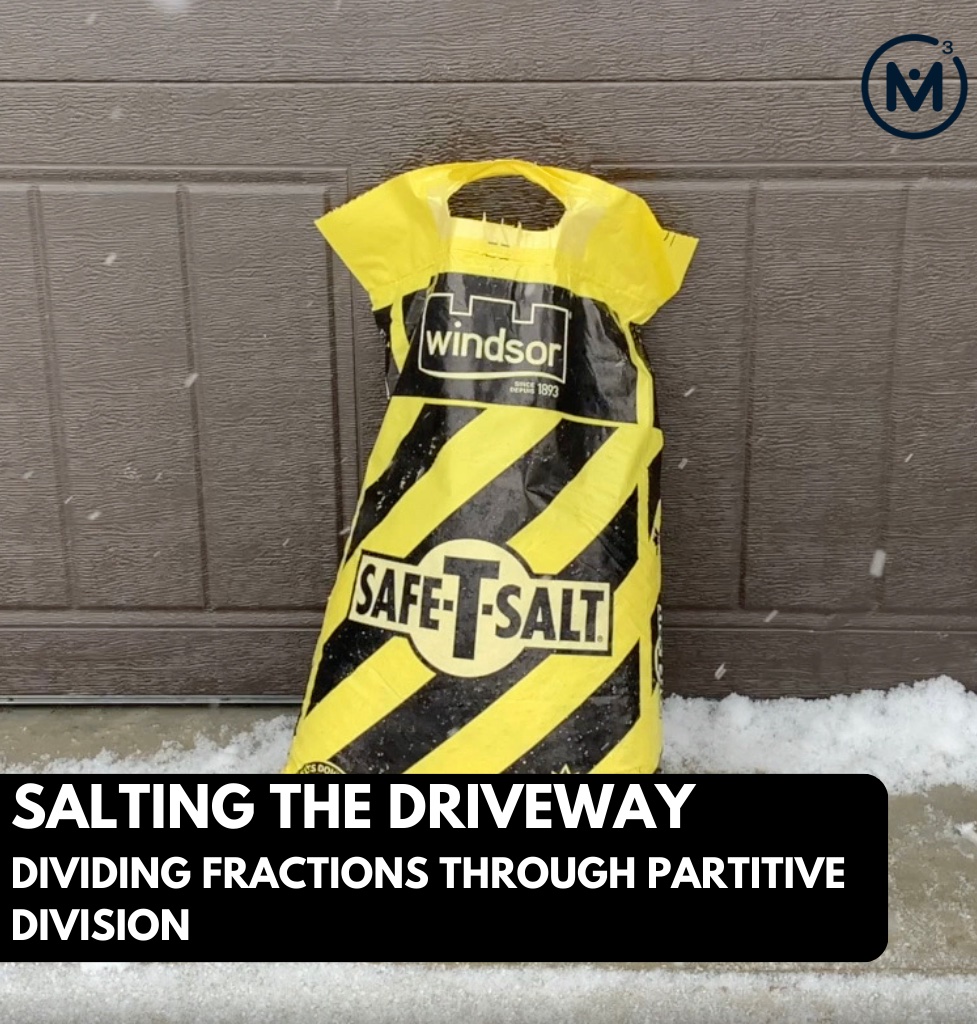
Length of Unit: 6 Days
Access each lesson from this unit using the navigation links below
Students will determine the number of bags of salt needed to de-ice one whole driveway.
Intentionality…
In this task, students will observe a driveway being salted using one bag of salt. The shoveller will salt a fraction of the driveway, and in doing so, use a fraction of a bag. Students are then asked to determine how many bags of salt will be needed to de-ice the entire driveway given this information.
Some of the big ideas that may emerge through this task include:
- Partitive division is one of the two types of division;
- When dividing partitively, the dividend and the divisor often (not always) have two distinct units;
- The resulting quotient has a compound unit (quantity of dividend per one unit of divisor);
- The dividend and the divisor are a ratio before the division is performed;
- The quotient in a partitive division problem is a rate; and,
- The quotient can be revealed through scaling the ratio in tandem to one whole of the divisor.
Spark Curiosity
What Do You Notice? What Do You Wonder?
Show students the following video:
Then, ask students:
What do you notice?
What do you wonder?
Give students 60 seconds (or more) to do a rapid write on a piece of paper.
Replaying the video and/or leaving a screenshot from the video up can be helpful here.
Then, ask students to share with their neighbours for another 60 seconds.
Finally, allow students to share with the entire group. Be sure to write down these noticings and wonders on the blackboard/whiteboard, chart paper, or some other means to ensure students know that their voice is acknowledged and appreciated.
Some of the noticing and wondering that may come up includes:
- I notice a house.
- I wonder where it is.
- I wonder who lives there.
- I notice a bag in his hand.
- I wonder what is in the bag.
- I notice that he is shaking the content of the bag onto the driveway.
- I notice that he is using salt.
- I wonder if he will cover the whole driveway.
- I wonder why he is doing that.
- I wonder if he will use the whole bag.
- I wonder how long it will take him.
At this point, you can answer any wonders that you can cross off the list right away. For example:
- This is a driveway in Belle River, Ontario.
- He is salting the driveway.
- People salt their driveway to de-ice them so that they are not slippery.
Estimation: Prompt
After we have heard students and demonstrated that we value their voice, we can land on the first questions we will challenge them with:
About how much of the driveway did he salt?
About how much of the bag of salt did he use?
Make an estimate.
We can now ask students to make an estimate (not a guess) as we want them to be as strategic as they can possibly be. This will force them to determine a fraction of the driveway and the bag that would be reasonable before determining a more precise answer. Consider asking students to think about an estimate that would be “too low” and an estimate that would be “too high” before asking for their best estimate in order to help them come up with a more reasonable estimate. Encourage students to share their estimates, however avoid sharing their justification just yet. We do not want to rob other students of their thinking.
Facilitator Note:
The prompt intentionally omitted the word “fraction”. You might hear students describing the amount of driveway and the bag using fractional language, decimal language or standard units of measure. All descriptions of the amount are welcome. This might be a great opportunity to discuss equivalence.
Estimation: Partial Reveal & Update
Share the following image with students revealing that one-third of the driveway has been salted:
Follow up with another short clip showing that he used one-fourth of the bag of salt:
Here’s a screenshot to summarize the fraction of the driveway that was salted and the fraction of the bag of salt that was used:
Celebrate student estimates that were very close to the actual fraction of the driveway and fraction of the bag used via a routine of your choice as we head into the sense making portion of this lesson.
Fuel Sense-making
Crafting A Productive Struggle: Prompt
Prompt students by stating:
About 1 fourth of the bag was used to salt 1 third of the driveway.
How many bags will he need to salt the whole driveway?
Students should reason through this prompt without the use of a calculator. Visual or concrete representations should be encouraged.
During Moves
While Students Are Productively Struggling…
Monitor student thinking by circulating around the room and listening to the mathematical discourse. Select and sequence some of the student solution strategies and ask a student from the selected groups to share with the class from:
- most accessible to least accessible solution strategies and representations;
- most common/frequent to least common/frequent strategies and representations; or,
- choose another approach to selecting and sequencing student work.
The tools and representations you might see students using to convince their peers and/or the teacher include:
- Paper folding.
- Using an area model.
- Using a bar model.
- Using a number line.
- Using a ratio table.
- Using multiplication.
- Skip counting.
- Repeated addition.
Have students share their strategies and reasoning for how to determine how many bags of salt are needed to salt one whole driveway. Ask them to convince you and their peers that their answer is correct by sharing mathematical models.
Discuss their strategies and elicit student thinking during your consolidation to build off of their current prior knowledge and understanding rather than “fixing” or “funnelling” student thinking to a strategy and/or model that does not connect to their strategy and/or approach.
Student Approaches
Student Approach #1: Bar Model with Skip Counting
I drew the driveway. I split it into three equal parts. I know that one part needed ¼ of a bag. If that is true for the other two parts, I just need to count two more fourths of a bag. So they would use three-fourths of a bag.
Student Approach #2: Number Line with Repeated Addition
I know that one third of the driveway used one fourth of the bag. I also know that I am trying to find out how much for one whole driveway. I wrote 1 on my number line. And then I added thirds on the bottoms and fourths on the top. I need three-fourths of a bag for that one driveway.
Student Approach #3: Ratio table with Scaling (Multiplicative thinking)
I drew a ratio table with bags of salt and driveways. I know that to get to one whole driveway, I have to multiply the one-third by three. So I did the same to the bags of salt. One-fourth multiplied by three is three-fourths.
Next Moves
Consolidation
Take the opportunity to make connections between the various student representations. Consider how the students went about scaling the two quantities in tandem. You can use language such as “I see that you took this ratio, \(\frac{1}{3}\) driveway : \(\frac{1}{4}\) bag and you scaled it up”. Help students to see that this is in fact a ratio with two unique units. How did they approach the scaling? Through skip counting? repeated addition? Multiplicative thinking?
After reviewing student models and making connections between the representations and strategies, write the following statement on the board.
\(\frac{1}{4}\) ? \(\frac{1}{3}\) = \(\frac{3}{4}\)
Ask the following question:
Which operator did we use?
Engage students in a conversation about whether it would make sense to replace the blank with an addition, subtraction, multiplication or division. Ultimately landing on the idea that the operator needed to solve today’s problem was division, specifically partitive division.
he ratio of number of salt bags : number of driveways was divided partitively.
When partitive division is used, the quotient always reveals how many per one of the divisor, a rate. It might be beneficial to explore this relationship with friendly whole numbers to confirm that this is in fact true.
Reflect and Consolidation Prompts
Provide students an opportunity to reflect on their learning by offering these consolidation prompts to be completed independently.
Consolidation Prompt #1:
If one-fifth of a bag was used to salt one-fourth of a driveway, how many bags does he need to salt the entire driveway? Model and solve.
Write the scenario above as a division sentence. Include the appropriate units.
Consolidation Prompt #2:
The relationship between the bags of salt and the driveway can be represented as a ratio. When you divide the bags of salt by the number of driveways, you reveal a rate. Is this statement true? Why or why not?
We suggest collecting this reflection as an additional opportunity to engage in the formative assessment process to inform next steps for individual students as well as how the whole class will proceed.
Resources & Downloads
Printable Lesson Plan PDF
Videos, Images & Media Files
Apple Keynote Presentation
Powerpoint Presentation
Printable Consolidation Prompts
Educator Discussion Area
Login/Join to access the entire Teacher Guide, downloadable slide decks and printable handouts for this lesson and all problem based units.
Explore Our 60+ Problem Based Units
This Make Math Moments Lesson was designed to spark curiosity for a multi-day unit of study with built in purposeful practice, number talks and extensions to elicit and emerge strategies and mathematical models.
Dig into our other units of study and view by concept continuum, grade or topic!



